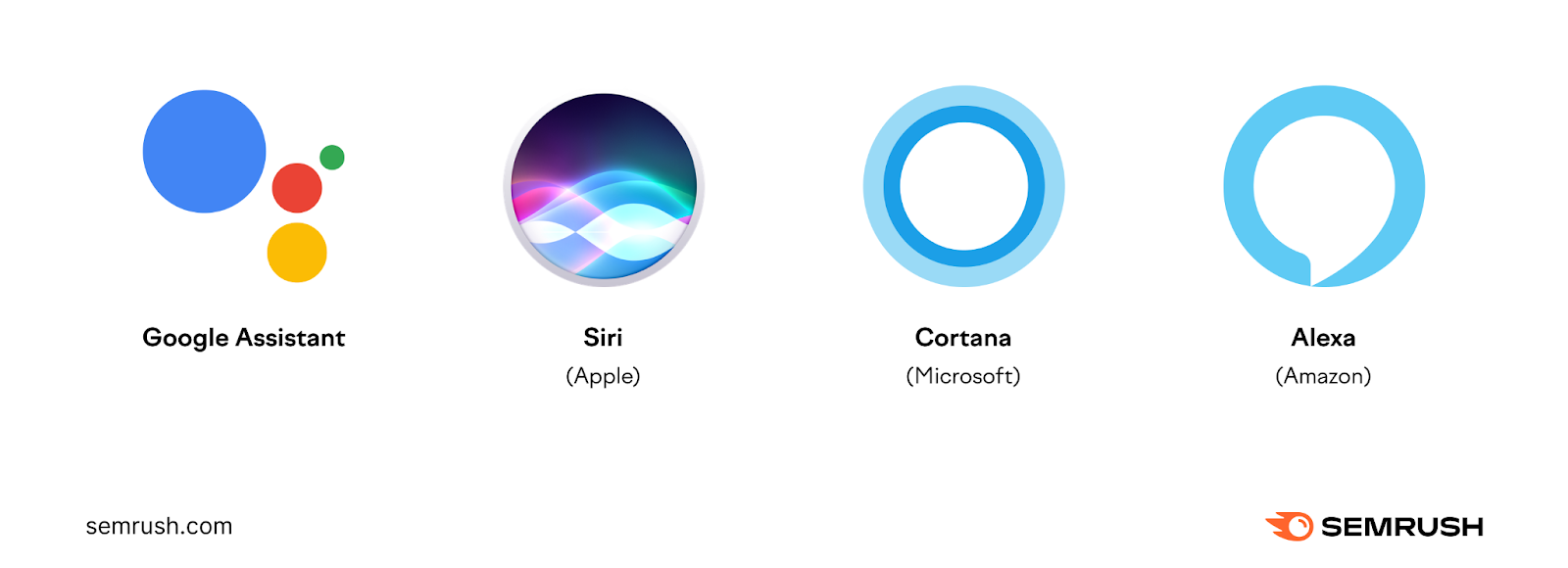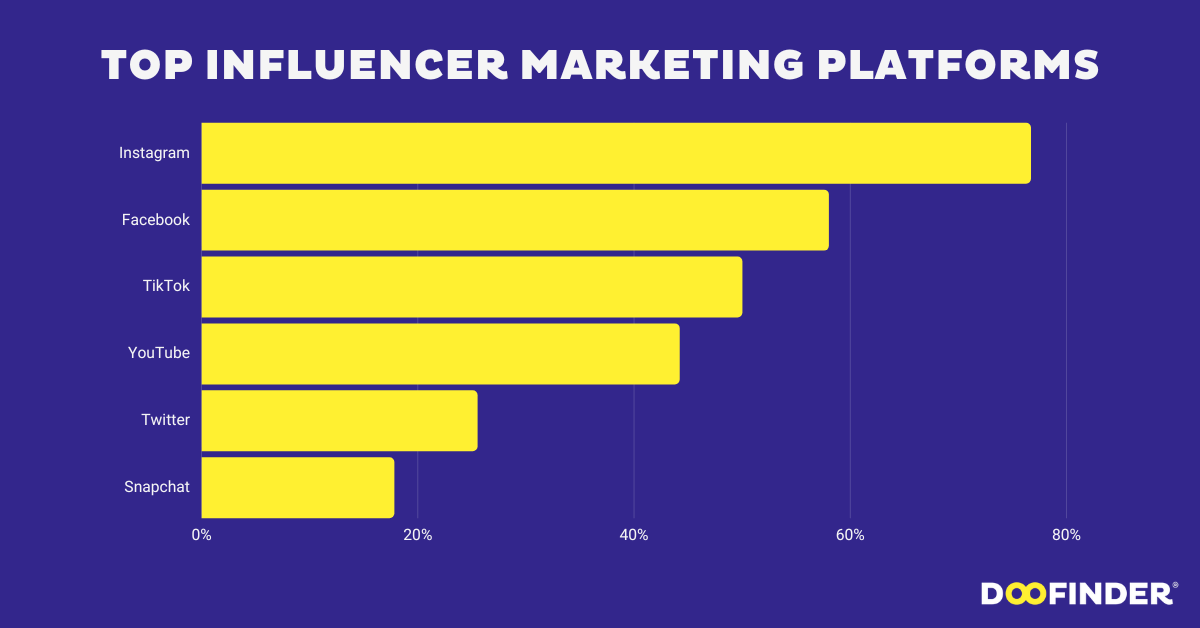
Latest and Emerging Digital Marketing Trends
Voice Search Optimization
As technology is advancing, Voice Search Optimization has created its own space in the upcoming digital marketing trends. It has become a game-changer revolutionizing the way individuals interact with search engines.
What is Voice Search Optimization (VSO)?

Source: SEMRUSH
It is an approach that allows users to articulate their thoughts and concerns verbally. It operates through a speech-recognition technology that transforms your voice into actionable commands for search engines.
As the usage of voice-activated devices such as smartphones, and speakers is increasing, VSO is focusing on optimizing content that aligns with the natural human voice. This also involves adapting keywords, structuring content, and providing concise informative answers.
The goal of voice-activated search is that whenever someone uses their voice to search for a particular thing, the website must appear in the search result. This makes the user experience seamlessly better.
Voice search assistants like Siri, Alexa, and Google Assistant represent a profound shift in user behaviour. This hand-free search method has become an integral part of our daily routine which reflects the desire for convenience and efficiency.
With over 4 billion voice-activated searches, it has become ingrained in daily routines. Over 50% of internet queries will be voice-based by 2022, according to statistics. To meet the evolving consumer preference for voice search, businesses need to adapt their online presence to accommodate voice technology.
Understanding Voice Search
Voice search operates on natural language processing (NLP) technology that recognizes the words spoken by humans. With the help of this, spoken languages are converted into texts which are then processed to search relevant results for us. This speech-to-text optimization has been used by different voice assistants.
Voice recognition technology is majorly used in smart speakers, and phones. Smart speakers like Amazon Echo, and Google Home are popular platforms with users using voice commands to perform any task or seek information. Android and iOS phones are also equipped with a hands-free search assistant.
Even though there are similarities, the difference lies in preference and user behaviour. While hands-free search is more convenient if you’re occupied, text searches are more deliberate and detailed.
Why Does Voice Search Optimization Matter?

Image source: searchenginejournal
Semantic search has become so crucial nowadays for users because of its convenience of not touching the device or rather not moving from one place to another.
Why is Voice Search becoming important in digital marketing?
The impact of voice search algorithms is profound in the digital marketing sector. To be successful with voice search, businesses need to incorporate natural language phrases and long-tail keywords.
The overall search engine ranking is now affected by content that aligns with these patterns, as Google's algorithms prioritise content aligning with these patterns.
Users expect quick, concise, and accurate responses and businesses must adapt content to match these expectations to provide valuable information and meet users' needs.
What are the Challenges in Optimising for Voice Search?
Due to its conversational nature, it creates a few challenges for both the end users and the developers. More often than not, the virtual assistants interpret something different than the spoken words resulting in wrong information. Balancing concise yet informative responses is the key to effective voice search optimization.
Voice Search Optimization Strategies
Image source: Digi Venders
VSO demands tailored strategies and one of those is comprehensive keyword research that usually helps in identifying the natural language that users commonly speak.
Enhance the visibility of voice search results by implementing structured data and schema markup. Search engines can better understand and present information as a result.
By creating conversational, concise, and informative responses for voice search, you can optimize website content. Local SEO tactics should be integrated into voice search optimization for businesses with physical locations. Enhance the prominence of "near me" queries by keeping business information accurate and easily accessible.
To achieve true VSO, it is vital to consider the nuances of spoken language, user intent, and technological interfaces.
Create a seamless user experience by adopting a user-centric mindset, customizing strategies to enhance accessibility, and providing valuable, voice-friendly content.
Voice Search and Mobile Optimization

Image source: searchenginejournal
Voice search and mobile optimization are connected as voice queries are predominantly made on mobile devices. The use of smartphones has increased over the years which has revolutionized the voice search trends.
A mobile-friendly website design is essential for voice search optimization. Websites must be responsive, and user-friendly, ensuring a seamless experience across every screen size.
Today, many applications have also integrated conversational AI that enhances user engagement. The connection between smartphones and voice searches is also important in terms of digital marketing. Since the number of mobile phone users is increasing, businesses should prioritize mobile optimization.
Voice Search and Conversational AI
Voice recognition technology is reshaping the way users interact with the technology. The popularity of virtual assistants such as Siri, Google Assistant, and Amazon Alexa has increased voice search usage. To understand and respond to user queries, these platforms use Natural Language Processing (NLP) algorithms.
The voice search and conversational AI like chatGPT, deliver relevant responses by understanding user intent and context. Users can now purchase and transact using voice commands thanks to voice commerce. Customer shopping experiences are streamlined when voice-enabled features are integrated into e-commerce platforms.
With users increasingly relying on voice search and conversational AI for information and transactions, optimization is essential. To enhance customer satisfaction and engagement in this evolving digital landscape, businesses must create conversational experiences tailored to voice-enabled devices.
The Future of Voice Search
Image source: Karan K
With the rapid growth in technology and especially in voice search, user interaction with digital platforms is taking a new shape. Voice search capabilities continue to be refined by developments in natural language processing (NLP), machine learning, and artificial intelligence (AI).
As virtual assistants and smart speakers become more popular, voice search usage is predicted to continue rising. Personalized voice search, based on individual preferences and behaviour patterns, is expected to become more common as recognition technology improves.
Creating voice-enabled experiences and optimizing content for long-tail keywords are all part of this process. Structured data can be leveraged for enhanced visibility. Users will increasingly use voice commands to request local information and make purchases, so optimizing for local search will be crucial.
Statistics About Voice Search Optimization
- More than 90% of the search queries are answered precisely by voice search assistants.
- Voice search users are significantly growing, and currently, it is reported to be 125.2 million in 2023. In 2022, the number was around $123.5 million.
- On average, Voice search result pages load in just 4.6 seconds.
- More than 1 billion voice queries are made by end users every month.
- In the year 2026, the voice search market is reported to reach $ 27.16 billion. In 2020, the market value was just $10.7billion.
- 27% of voice searches took place through mobile devices in the year 2023.
- More than 50% of Adults around the globe are using voice search daily.
- More than 50% of consumers use voice search to know about local businesses.
Influencer Marketing

Source: WarriorForum
In the ever-evolving world of marketing, and advertising, influencer marketing has emerged as a powerful strategy for brands to connect with their target audience.
Influencer marketing involves partnering with individuals who have dedicated and engaged following on their social media platforms. They are commonly known as social media influencers and they can influence the purchasing decisions of their audience.
The credibility, authenticity, and reliability of each influencer are what sets them apart. The personal touch and authenticity of content creators can make customers resonate with them resulting in higher trust in the promoted product or services.
Influencer collaboration can benefit brands in various ways. Through influencers, brands can reach potential customers who align with their target audience. Moreover, influencers can bring more authenticity and credibility to brand partnerships. The result of this trust is increased brand awareness, improved brand perception, and ultimately, higher conversion rates for the brand's products or services.
Additionally, influencer marketing can offer high returns on investment for brands looking to maximize their marketing budgets, making it a cost-effective strategy. In today's competitive digital landscape, collaborating with influencers offers brands unique opportunities to expand their reach, build meaningful relationships with consumers, and drive business growth.
Types of Influencers

Influencer marketing is at its peak and there are various types of influencers wielding their impact on their audience. Digital influencer’s audience interaction, engagement, and reach might differ depending on various factors such as their content, their consistency of posting, and more.
Social media influencers are categorized into mega-influencer, macro-influencer, micro-influencer, and nano-influencers. This categorization is based on the number of followers they have.
Mega-influencers often have more than a million followers on Instagram or any other social media platform. Although macro-influencers have a less extensive reach, they retain a substantial audience, ranging from 100,000 to one million. Micro-influencers are those who have followers anywhere between 10,000 to 100,000. A nano-influencer, the smallest tier, has fewer than 10,000 followers.
A micro or nano influencer emphasizes authenticity and personalized connections, while a mega or macro influencer thrives on wide visibility. It is important to choose an influencer by your campaign objectives, target audience, and desired level of engagement.
Adapting brands' campaigns to the nuances of each influencer category can result in more authentic and relatable campaigns.
Finding the Right Influencers

Every brand has its story to tell and they need to find the right influencer to reach their audience. The approach here should be identifying influencers in your reach or industry and evaluating their engagement, and authenticity.
But, how do you identify the right influencers for a marketing campaign?
While identifying influencers in your industry, you require thorough research on their content and social media engagement. This also involves analyzing social media channels, blogs, and other online platforms.
Various tools and platforms help streamline the process of finding the right influencer.
Analyzing social media data and identifying influencers based on demographics, engagement metrics, and content relevance are among the factors considered by these tools. BuzzSumo, Traackr, and HypeAuditor are three tools popular for finding influencers.
It is important for brands to carefully select influencers who align with their brand's values and target audience to maximize the effectiveness of their influencer marketing campaigns and authentically connect with consumers.
Building Relationships with Influencers
Source: sproutsocial
A healthy relationship with macro and micro-influencers can result in successful marketing campaigns. The process involves reaching out to influencers, establishing contacts, negotiating contracts, compensations, and long-term relationships.
A brand should also research the influencers they want to collaborate with. You should know their content and audience, and should express genuine interest in collaborating. Make sure that you are transparent about your budget and also understand what the influencer can bring to the table.
The authentic influencer partnerships’ contract outlines deliverables, timelines, and compensation arrangements. Both parties are also protected by clarifying expectations and resolving potential issues upfront. Make sure contracts are clear, concise, and legal, addressing important issues like content ownership and exclusivity.
Communicate regularly, support the influencer, and appreciate their work to build long-term relationships. Provide frequent engagement with their content, feedback, and collaboration opportunities beyond individual campaigns.
A partnership is authentic and sustainable when trust and rapport are built between your brand and the influencer's audience.
Crafting Effective Influencer Campaigns
Image source: sproutsocial
A successful influencer campaign requires a strategic approach aligned with the brand's goals and leveraging influencers' unique strengths.
Before you launch a campaign, define clear goals and objectives, whether it's to increase brand awareness, drive sales, or launch a new product. Based on these goals, a campaign's direction and success metrics can be determined.
Content ideas that are creative and engaging capture the audience's attention and resonate authentically with them. Working with influencers to brainstorm innovative concepts ensures that the content is both on brand and in line with their audience's interests and preferences.
Brands can create effective influencer campaigns by designing creative content that resonates with their target audience.
By incorporating user-generated content and influencer-generated content, the campaign becomes more authentic and diverse and is more likely to be successful.
You can measure campaign success and ROI by tracking key performance indicators (KPIs) such as reach, engagement rates, and conversions.
Read more: The Smart Way to Measure Influencer Marketing ROI
Influencer Regulations and Compliance
For maintaining transparency and authenticity in influencer partnerships, influencer regulations and compliance play a vital role. Guidelines and legal requirements are essential aspects that both parties must adhere to while collaborating on sponsored content.
Many influencers disclose their partnership with a brand by using hashtags such as #ad #partner and more. In the United States, the Federal Trade Commission (FTC) guidelines require these disclosures not only as a matter of ethics but also as a requirement of various advertising standards and regulations worldwide.
The credibility of influencer marketing increases through regulations and compliance which results in long-term successful relationships between brands, content creators, and their followers.
Influencer Marketing on Different Platforms

With so many platforms nowadays like Instagram, TikTok, and YouTube, some creators are famous on each platform. Their unique approach to engaging with their audience differs on each one of them.
While Instagram and TikTok’s visual nature works best for fashion, beauty, and lifestyle content, consumers watch YouTube for long-form and more informed content.
Aesthetically pleasing visuals and genuine storytelling can appeal to audiences on Instagram but on YouTube, people crave more relatability, vlogs, and reviews.
Since each platform has its unique algorithm, audience demographic, and content trends, one needs to create tailored content and platform-specific strategies.
Maximum reach and engagement can be gained through customized content. Moreover, a genuine relationship with influencers who have a strong hold on each platform can enhance the effectiveness of influencer marketing across all platforms.
Bonus: The Ultimate Guide to Influencer Marketing [Free Templates]
Influencer Marketing Trends

Source: edkentmedia
Digital influencers and their social media engagement are at their peak and it’s not just of influencers over 500K or 1 million followers.
There’s a high growth in nano and micro-influencers, who possess smaller but highly engaged audiences. Brands are recognizing and targeting such influencers for their authenticity and ability to connect with their followers.
Live streaming and real-time engagement have also become a prominent feature in influencer marketing. Instagram and Facebook allow you to go live at any point which increases the interaction of the influencer with their followers.
The growing popularity of short-form content on social media has also reshaped the influencer marketing strategy. Brands are working on creative ways to showcase their product or service in a shorter period through reels, and shorts.
Ultimately, influencer marketing aims to leverage emerging trends, embrace new formats and platforms, and leverage technology to create innovative and authentic brand experiences. Adapting their strategies accordingly will enable brands to take advantage of influencer marketing opportunities.
Related: Influencer Marketing ROI Calculator
Influencer Marketing Statistics Show That
- Influencer marketing is rapidly growing. In 2023, influencer marketing was valued at $21.1 billion.
- Businesses are achieving $5.2 ROI for every $1 invested in influencer marketing, and some of the top 13% of businesses are making $20 or more for every $1.
- The phrase "influencer marketing" has seen a 465% increase in queries and searches on Google since 2016
- More than 80% of respondents of a survey trust influencer marketing as an effective form of marketing.
- 67% of businesses or brands use Instagram for influencer marketing.
- 1360 service agencies or platforms have entirely focused on influencer marketing for the last 5 years.









Leave A Comment